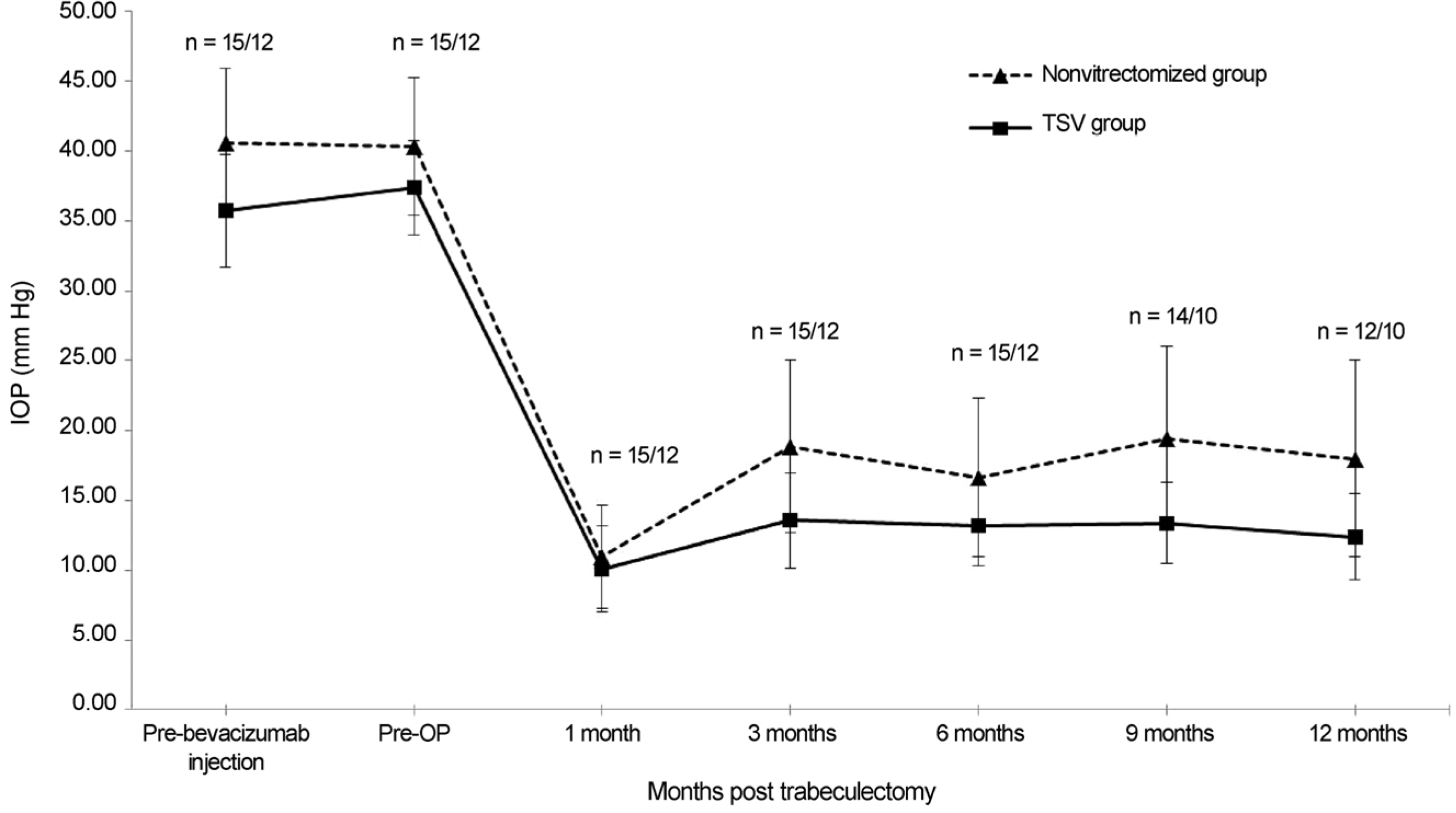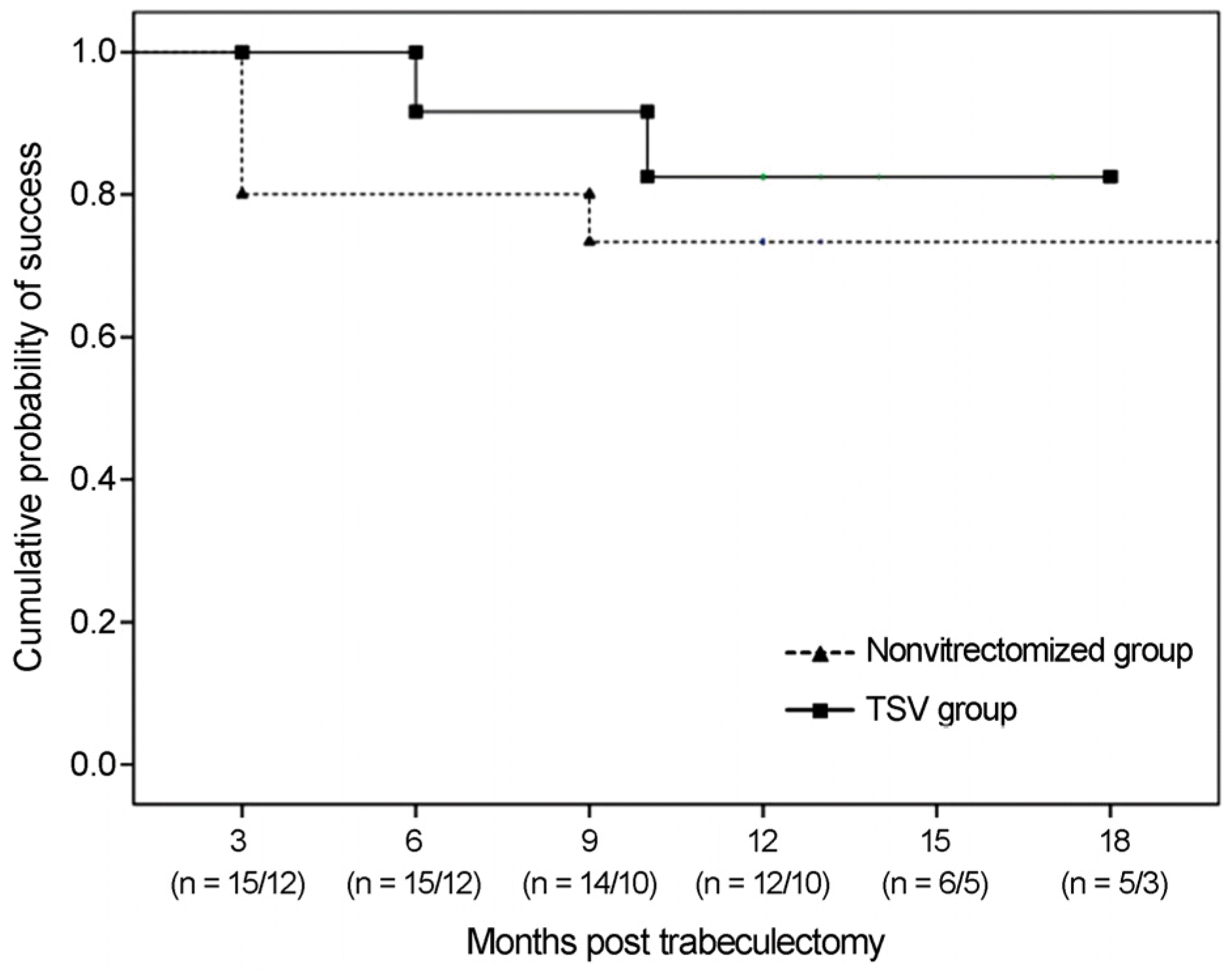Abstract
Purpose
To evaluate the efficacy of intravitreal bevacizumab and subsequent trabeculectomy with mitomycin C (MMC) for neovascular glaucoma (NVG) in eyes that underwent previous 23-gauge transconjunctival sutureless vitrectomy (TSV).
Methods
This was a retrospective, comparative, and consecutive case series study. We reviewed the medical records of patients with NVG who underwent trabeculectomy with MMC after intravitreal bevacizumab (1.25 mg/0.05 mL) injection and compared the surgical outcomes according to 23-gauge TSV history. Surgical success was defined as an intraocular pressure (IOP) of ≥6 mm Hg and ≤21 mm Hg without additional glaucoma surgery or loss of light perception. The main outcome measures were postoperative IOP control, visual acuity, and complications.
Results
A total of 27 patients (27 eyes) were included; 12 patients with 23-gauge TSV history (TSV group) and 15 patients without vitrectomy history (nonvitrectomized group). The cumulative probability of success after trabeculectomy with MMC was 82.5% and 73.3% after one year for the TSV group and the nonvitrectomized group, respectively (p = 0.523). Mean IOP decreased from 37.3 ± 9.0 mm Hg preoperatively to 12.8 ± 6.2 mmHg at the final visit in the TSV group (p = 0.002). Mean IOP decreased from 40.3 ± 9.7 mm Hg preoperatively to 17.8 ± 11.7 mm Hg at the final visit in the nonvitrectomized group (p = 0.001). Preoperative and final IOP were not significantly different between the two groups. Complications were comparable between the groups.
References
1. Goto A, Inatani M, Inoue T, et al. Frequency and risk factors for neovascular glaucoma after vitrectomy in eyes with proliferative diabetic retinopathy. J Glaucoma. 2013; 22:572–6.

2. Broadway DC, Grierson I, Hitchings RA. Local effects of previous conjunctival incisional surgery and the subsequent outcome of filtration surgery. Am J Ophthalmol. 1998; 125:805–18.

3. Broadway DC, Chang LP. Trabeculectomy, risk factors for failure and the preoperative state of the conjunctiva. J Glaucoma. 2001; 10:237–49.

4. Takihara Y, Inatani M, Fukushima M, et al. Trabeculectomy with mitomycin C for neovascular glaucoma: prognostic factors for surgical failure. Am J Ophthalmol. 2009; 147:912–8. 918.e1.

5. Kiuchi Y, Sugimoto R, Nakae K, et al. Trabeculectomy with mitomycin C for treatment of neovascular glaucoma in diabetic patients. Ophthalmologica. 2006; 220:383–8.

6. Nissen NN, Polverini PJ, Koch AE, et al. Vascular endothelial growth factor mediates angiogenic activity during the proliferative phase of wound healing. Am J Pathol. 1998; 152:1445–52.
7. Hu DN, Ritch R, Liebmann J, et al. Vascular endothelial growth factor is increased in aqueous humor of glaucomatous eyes. J Glaucoma. 2002; 11:406–10.

8. Tripathi RC, Li J, Tripathi BJ, et al. Increased level of vascular endothelial growth factor in aqueous humor of patients with neovascular glaucoma. Ophthalmology. 1998; 105:232–7.

9. Yeom MI, Kim NE, Lee SJ, Park JM. Prognostic factors for neovascular glaucoma after vitrectomy in eyes with proliferative diabetic retinopathy. J Korean Ophthalmol Soc. 2015; 56:1229–35.

10. Inoue T, Inatani M, Takihara Y, et al. Prognostic risk factors for failure of trabeculectomy with mitomycin C after vitrectomy. Jpn J Ophthalmol. 2012; 56:464–9.

11. Yanyali A, Celik G, Dincyildiz A, et al. Primary 23-gauge vitreoretinal surgery for rhegmatogenous retinal detachment. Int J Ophthalmol. 2012; 5:226–30.
12. Ahn SJ, Woo SJ, Ahn J, Park KH. Comparison of postoperative intraocular pressure changes between 23-gauge transconjunctival sutureless vitrectomy and conventional 20-gauge vitrectomy. Eye (Lond). 2012; 26:796–802.

13. Alkawas AA, Shahien EA, Hussein AM. Management of neovascular glaucoma with panretinal photocoagulation, intravitreal bevacizumab, and subsequent trabeculectomy with mitomycin C. J Glaucoma. 2010; 19:622–6.

14. Fakhraie G, Katz LJ, Prasad A, et al. Surgical outcomes of intravitreal bevacizumab and guarded filtration surgery in neovascular glaucoma. J Glaucoma. 2010; 19:212–8.

15. Miki A, Oshima Y, Otori Y, et al. One-year results of intravitreal bevacizumab as an adjunct to trabeculectomy for neovascular glaucoma in eyes with previous vitrectomy. Eye (Lond). 2011; 25:658–9.

16. Huh HD, Han YS, Chung IY, et al. Comparision between simultaneous intracameral and intravitreal injection and intravitreal injection of bevacizumab in neovascular glaucoma. J Korean Ophthalmol Soc. 2014; 55:1039–48.

17. Chung HY, Chung HJ, Choi JY, et al. Risk factors for neovascular glaucoma after vitrectomy in patients with proliferative diabetic retinopathy. J Korean Ophthalmol Soc. 2013; 54:1868–74.

18. Itakura H, Kishi S, Kotajima N, Murakami M. Persistent secretion of vascular endothelial growth factor into the vitreous cavity in proliferative diabetic retinopathy after vitrectomy. Ophthalmology. 2004; 111:1880–4.

19. Chen CH, Lai IC, Wu PC, et al. Adjunctive intravitreal bevacizumab-combined trabeculectomy versus trabeculectomy alone in the treatment of neovascular glaucoma. J Ocul Pharmacol Ther. 2010; 26:111–8.

20. Lee YH, Kim R, Chang SD. The effect of intravitreal bevacizumab injection before trabeculectomy in patients with neovascular glaucoma. J Korean Ophthalmol Soc. 2015; 56:917–24.

21. Takihara Y, Inatani M, Kawaji T, et al. Combined intravitreal bevacizumab and trabeculectomy with mitomycin C versus trabeculectomy with mitomycin C alone for neovascular glaucoma. J Glaucoma. 2011; 20:196–201.

22. Chilov MN, Grigg JR, Playfair TJ. Bevacizumab (Avastin) for the treatment of neovascular glaucoma. Clin Experiment Ophthalmol. 2007; 35:494–6.

Figure 1.
Changes in mean IOP after intravitreal bevacizumab injection and trabeculectomy with MMC. IOP at each time point was not significantly different between the two groups during the entire study period. The figures indicate the number of patients followed-up at the time (nonvitrectomized group/TSV group). The error bars are 95% confidence intervals (mean ± SE × 1.96). IOP = intraocular pressure; MMC = mitomycin C; TSV = transconjunctival sutureless vitrectomy; SE = standard error; Pre-OP = preoperative.

Figure 2.
Cumulative probabilities of surgical success after intravitreal bevacizumab injection and subsequent trabeculectomy with MMC in the TSV group (solid line) and nonvitrectomized group (dotted line). The success rate was not statistically significantly different between the two groups (p = 0.523; Mantel-Cox log rank test). The figures under the horizontal axis represent the number of patients followed-up at the noted time (nonvitrectomized group/TSV group). MMC = mitomycin C; TSV = transconjunctival sutureless vitrectomy.

Table 1.
Demographic and clinical characteristics of the study patients
Table 2.
Preoperative and postoperative IOP in the study groups
| TSV group | Nonvitrectomized group | p-value between two groups | |
|---|---|---|---|
| Pre-bevacizumab injection IOP (mm Hg) | 35.8 ± 7.4 | 40.6 ± 10.5 | 0.32 |
| Preoperative IOP (mm Hg) | 37.3 ± 9.0 | 40.3 ± 9.7 | 0.35 |
| IOP at final visit (mm Hg) | 12.8 ± 6.2 | 17.8 ± 11.7 | 0.30 |
| p-value | 0.002* | 0.001* |
Table 3.
The changes in mean number of glaucoma medications in the study groups
| TSV group | Nonvitrectomized group | p-value between two groups | |
|---|---|---|---|
| Preop. number of medications | 3.92 ± 0.29 | 3.53 ± 0.52 | 0.08 |
| Postop. number of medications | 0.67 ± 1.23 | 1.07 ± 1.33 | 0.40 |
| p-value | 0.002* | 0.001* |
Table 4.
The changes in mean BCVA (log MAR) in the study groups
| TSV group | Nonvitrectomized group | p-value between two groups | |
|---|---|---|---|
| Preop. BCVA | 1.7 ± 0.9 | 1.4 ± 1.1 | 0.37 |
| Postop. BCVA | 1.65 ± 1.1 | 1.57 ± 1.2 | 0.76 |
| p-value | 0.55* | 0.71* |




 PDF
PDF ePub
ePub Citation
Citation Print
Print


 XML Download
XML Download